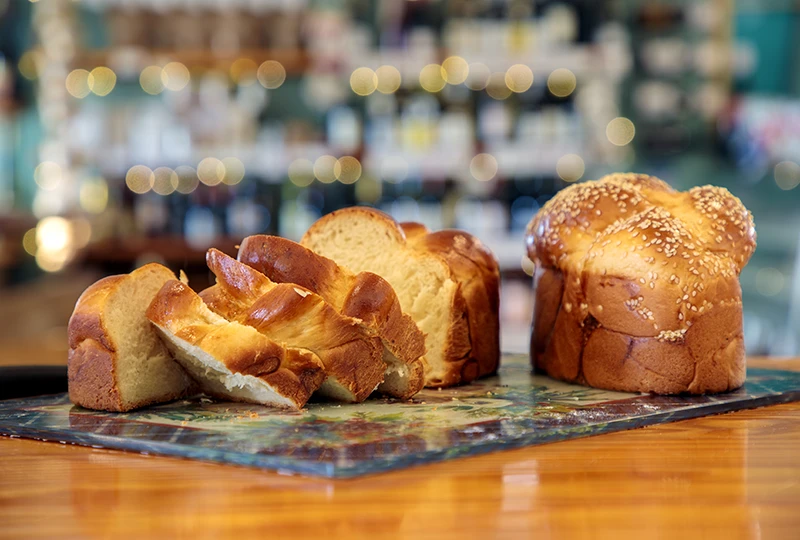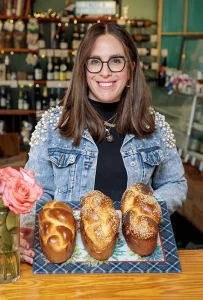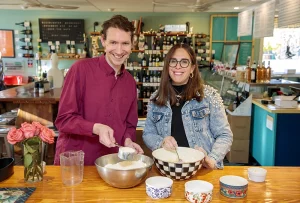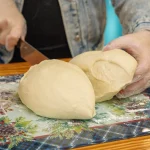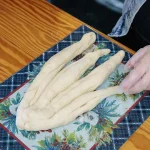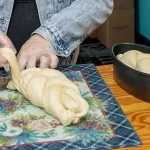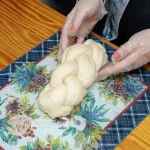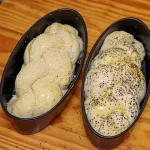by Michael Vyskocil, photography by Nikola Tzenov
Beyond the Braids
Feigie Cohen Shares the Tradition of Challah Bread and a Step-by-Step Recipe
On virtually every table at holiday time, you’ll find some type of bread. For Italians, it’s the sweet panettone. For Scandinavians, it might be the kanellängd, or cinnamon bread. For those of the Jewish faith celebrating Hanukkah, it’s challah. The elegantly braided bread, made with eggs and yeast, is steeped in a rich tradition filled with symbolism.
For Feigie Cohen, program director of the Chabad Jewish Center of Carroll County, baking challah means upholding a Jewish tradition that has been passed down from generation to generation. The bread for this article was prepared and baked in Cohen’s kosher kitchen. We would like to thank JeannieBird Bakery in Westminster for the use of their bakery as the backdrop for the photography of the challah bread.
“As a child, I loved coming home from school on Friday afternoon and smelling the delicious aroma. It’s a tradition that brings peace, love and comfort into a home,” she says. “That was ushered in by the Friday night dinner with family and friends, which we call Shabbat.”
Each week, Cohen prepares 10 loaves of her freshly baked challah. Her husband, Rabbi Sholly, delivers several of her freshly baked challah loaves to those in need. Growing up, Cohen says she loved the taste of her mother’s challah, a water-based challah that was served with various condiments and dips. Cohen’s challah is a sweeter version, and the recipe is one shared among her sisters and cousins. “It’s the perfect balance between not to sweet and not water-based,” she explains.
Making challah is a family activity, and Cohen involves her youngest children, her twins, in preparing the challah for Shabbat on Friday evening. Every week, the challah can be different — sometimes sprinkled with sesame seeds or accented with rosemary. For holidays, she might incorporate a sweet crumb topping or have the kids garnish with chocolate chips.
Preparing challah is a type of mitzvah, a Jewish commandment, which is said to bring blessings upon one’s loved ones. “I feel like it’s an honor every week to make the challah and continue this tradition that has been passed on for generations and generations. It’s something that I enjoy doing,” she says.
After she prepares the challah dough and before braiding it, Cohen sets aside a portion of the dough and says a blessing over it. This act reminds her of the importance of thinking about others and providing for those in need. Braiding the dough symbolizes unity, bringing people together to create oneness.
Cohen assures the home baker that challah is not difficult to prepare. As she creates her challah, Cohen reflects on the significance of each ingredient. “Each step in the process contributes a specific prayer for your home and your family,” she says. “Each ingredient will reflect another blessing and help fulfill a need for ourselves and our families.”
Fergie Cohen’s Challah
This Jewish bread, traditionally eaten on special holidays and Shabbat, is as delightful to make as it is to eat. You can eat it plain by itself or serve it with accompaniments such as an eggplant dip or olive tapenade. The ideal texture of the unbaked challah dough should be fluffy and airy, but it should also be stiff enough to be rolled to achieve its characteristic braided design.
Makes 2 challah.
| 2 cups warm water, warmed to 100 degrees F. | 1/2 cup canola or vegetable oil |
| 1/2 cup granulated sugar | 2 eggs, lightly beaten |
| 1 tablespoons active dry yeast | About 6 cups unbleached bread flour (or just enough to create a workable dough), plus more for dusting |
| 1 tablespoon Himalayan pink salt or coarse kosher salt | Desired toppings, such as poppy seeds or sesame seeds |
- Combine water, sugar and yeast in a large mixing bowl. Set bowl aside for 2 to 3 minutes, until bubbles begin rising on the surface of the mixture.
- Add salt, oil and 1 egg to yeast mixture; stir to combine. Gradually add approximately 6 cups flour and, with your hands, knead each addition of flour into the dough. Incorporate just enough flour to create a workable dough. Loosely cover bowl with plastic wrap and let dough rise in a warm place until almost doubled in bulk, about 30 minutes.
- Preheat oven to 350 degrees F. Line two baking sheets with parchment paper and set aside.
- Divide dough into two pieces. Divide each piece into three or four equal pieces. Place pieces on a lightly floured work surface and roll each piece into a log about 12 inches long, leaving the middle slightly thicker than the ends. Lay logs side by side lengthwise. Pinch together ends farthest from you, then braid strands. Tuck ends of braid underneath. Transfer braids to prepared baking sheets. Cover loosely with plastic wrap and let rise for about 45 minutes.
- Right before baking, brush the surface of the challah with 1 beaten egg. Sprinkle with desired toppings. Bake for 30 minutes or until golden brown. Remove to a baking rack to cool slightly. Slice and serve with desired dips or other accompaniments.
- 1. Cutting the dough.
- 2. Arranging the dough.
- 3. Braiding the dough.
- 4. Braiding the dough.
- 5. Prepped dough.
Yeast – Represents growth and expansion, a desire for loved ones to reach their emotional and spiritual potential.
Sugar – Represents the sweetness or blessings in our lives, a hope for positivity and joy for every person.
Water – Represents the Jewish Torah, which spiritually nourishes the Jewish people.
Eggs – Represent the renewal of the life cycle, the hope of possibility and potential.
Salt – Represents criticism, discipline and rebuke; also represents purification for the mind, body and soul.
Flour – Represents material blessings, one’s livelihood, financial sustenance and blessings for love and relationships.
Oil – Represents blessings to be poured out upon each individual in the family.
Special Thanks to Jeannie Bird Bakery in Westminster for use of their facility.

